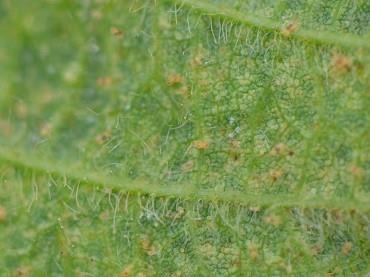By Bruce Potter and Bob Koch et.al
The hot, dry growing season has led to infestations of two-spotted spider mites in many areas of Minnesota. Over the past two weeks, increasing numbers of fields with economic infestations have been observed. Most, but not all, have been in areas with obvious drought stress. Soybeans appear to have the heavier infestations although spider mites also be found in corn and other crops.
Complicating these developments are reports of inconsistent performance of chlorpyrifos (e.g., Lorsban), presumably due to populations of resistant mites, which were first documented in Minnesota in 2012. Since then, chlorpyrifos applications to soybean and other crops have continued selection for resistant populations.
 |
| Close-up of two-spotted spider mites and eggs. |
Two-spotted spider mite populations are typically kept in check by predators, fungal disease, and adequate moisture. Warm, dry weather and moisture stress of the crop favor mite reproduction. When conditions are favorable for the mites, their rapid life cycle and high reproductive rates can quickly create large populations and damage crops. Other factors may accentuate mite populations, including some insecticides and fungicides. Once spider mite infestations are established and building, a single rainfall event or even short-term change in weather is not likely to stop an infestation.
 |
Heavy stippling on upper canopy leaves
caused by two-spotted spider mites. |
Mites and their damage often show up on field edges first because mites move into crops from adjacent perennial vegetation (pastures, roadside and drainage dishes, alfalfa fields, cover crops) where they overwinter. This movement is accelerated by both normal host maturity and by drought induced stress / dieback of host plants. Mites readily disperse by catching the wind with a silk thread. Higher numbers are typically caught near the field edge, but the dispersing mites can be found throughout the field. Populations on newly infested plants usually progress from lower leaves to the upper canopy with building mite numbers and deteriorating plant quality stimulating further dispersal throughout the field. The result: crop symptoms are typically noted first near the field edge, but the bulk of the field is usually not far behind.
However, not all fields follow the typical patterns. Mites can be easily found in some fields that have not been dry or currently showing drought stress and have received at least one heavy rainfall this season. Compaction, root disease, and SCN can induce moisture stress in years where moisture is otherwise adequate. Caution: Applications of many pyrethroid insecticides can flare spider mite populations and may not control soybean aphids. Additionally, there is evidence that, neonicotinoid insecticides may favor mite populations through several mechanisms and that fungicides may reduce the fungal attack on mites.
The presence of spider mites will affect pesticide decisions. Table 1 provides an overview of some important considerations for insecticides/miticides labeled for control of two-spotted spider mites in corn and soybean. In Minnesota, there is the potential for spider mites to be resistant to chlorpyrifos (e.g., Lorsban) and, perhaps, cross-resistant to dimethoate. Insecticides /miticides vary in which stages of mites they control. Rebound of mite populations after a pesticide application can occur through two mechanisms: Surviving adults and immatures that continue reproduce in the absence of beneficial insects; and rebound from uncontrolled eggs.
By the time infestations are detected on field edges, mites are likely well into the field. Because of this, border treatments are not advised without thoroughly scouting throughout the field.
When should a two-spotted spider mite infestation be treated?
The following infestation scale guidelines will help minimize the need to re-treat a field and minimize yield loss. Infestations and damage can progress quickly so be ready to act when a soybean field reaches 2 and treat when a field reaches a 3 on the following scale.
Damage isn’t reversible, so it's important to protect the middle and upper canopy leaves. At a rating of 3, there’s heavy stippling on the lower leaves with some stippling progressing into the middle canopy and very little in the upper canopy. At this point, mites will be common in the lower canopy, present in the middle canopy and with scattered colonies in the upper canopy. Some lower leaf yellowing will be common with accelerated leaf loss in small areas. In cooler weather, these symptoms will be less pronounced; focus on mite abundance and distribution.
Infestation scale: 0 to 5
0: No spider mites or injury observed.
1: Minor stippling on lower leaves. No premature yellowing observed.
2: Stippling common on lower leaves. Small areas with yellowing on scattered plants.
3: Spray threshold: Heavy stippling on lower leaves with some stippling progressing into the middle canopy. Mites present in the middle canopy, with scattered colonies in the upper canopy. Lower leaf yellowing is common, and there’s some lower leaf loss.
4: Economic loss: Lower leaf yellowing is readily apparent. Leaf drop is common. In the middle canopy, stippling, webbing, and mites are common. Mites and minor stippling present in the upper canopy.
5: Lower leaf loss is common, with yellowing or browning moving up the plant into the middle canopy. Stippling and distortion of the upper leaves are common. Mites are present in high levels in the middle and lower canopy.
Before you spray, scout to make sure mites are still present. Damage lags population buildup and doesn’t go away when mite populations crash or disperse. Tapping leaves over a piece of white paper can help detect live (moving) mites.
Thorough coverage of the canopy is important. Don’t skimp on water under dry / hot conditions. Make sure the applicator is using at least 5 gpa by air and 20 gpa by ground.
Because of potential pesticide resistance and population rebound from eggs, it is important to evaluate the efficacy of your mite control application within 5-7 days.
Avoid unnecessary pesticide applications. Insecticide and fungicide applications can adversely affect biological control and release spider mite populations.
Source : umn.edu